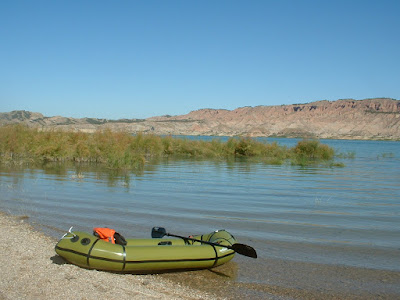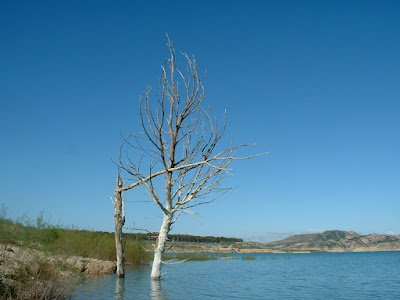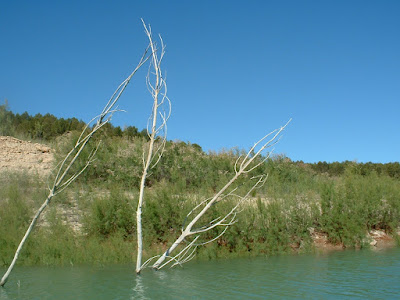January - 2025 starts well.
Some spells of nice settled weather enabled me to get on the water twice this month.
First trip was on Sat. Jan. 4th. when I took my Neris Smart 1 kayak to the Negratin reservoir. I don't often use the Smart One on the reservoir but on this occasion I wanted to visit the 'badlands' side, on the opposite shore to where I launch at Playa de Freila. I hadn't been to that side of the reservoir for a long time and the Smart One is a much better kayak for a lengthy open-water crossing. If an unexpected wind comes whistling up the reservoir the water can get quite rough, as I've found out a couple of times. Got on the water soon after 11:00 am and was back on shore 3½ hours later, after paddling 11.5 kilometres. Not surprisingly for January it was quite a cool morning, but there weren't any unexpected winds. It was a good start to my paddling year.
Second trip was on Sat. Jan. 25th. at Mojacar, with my packraft. Hadn't paddled this bit of the coast since I parted with my little Gumotex Twist kayak. Getting much larger (and heavier) kayaks to the water, across a wide expanse of soft sand, was off-putting. But it was dead easy with the packraft – carry everything across the sand in a largish hold-all, inflate the packraft at the edge of the water – and go. I'm really warming to the simplicity and capabilities of packrafts. Was on the water for 1¾ hrs. and paddled 5.0 kilometres of quite choppy water.
February - Sidetracked.
A stack of metal roofing sheets arrived - the final stage of re-roofing our shed/workshop. While the weather was looking good this task took priority over playing with kayaks.
March - No go.
Wet and unsettled weather for most of the month – a good test for the new roof on the shed/workshop. Weather definitely not conducive to the type of quiet kayaking I like.
April - Iffy.
Another month of very unsettled weather. Too unpredictable for my sort of kayaking at the places I like.
May - Back on the water.
Weather finally starting to settle down.
Took a chance on Saturday 3rd. and took my packraft to Punta Parda, Sea conditions were nice in the horseshoe-shaped bay, but there was too much swell for comfort, in a packraft, outside in open water. Spent the morning paddling circuits of the bay, more for exercise than anything else. Time on the water 1¾ hrs. and total distance paddled was 4.0 kilometres.
Saturday 24th. finally looked good for a trip to the Embalse de Negratin with my Gumotex Halibut kayak. A long time since I had seen such light winds forecast for that area. Got on the water soon after 10:00 am and spent a very pleasant 4 hours paddling around edges of the reservoir. Capacity is currently at 32% and the water level is the highest it has been for a couple of years – thanks to the wet and unsettled weather this spring. Total distance paddled was 10.0 kilometres.
A leg-stretch stop here. Even an inflatable seat starts to feel uncomfortable after two hours. My Gumotex Halibut kayak is perfect for my quiet paddling on sheltered waters. It's called a kayak but it is really more boat than kayak – and a very comfortable one.
June - Hot, hot,hot.
Temperatures now reaching uncomfortable levels by mid-morning, on most days – but the simplicity of my packraft enables me to get on the water very quickly. So, when sea conditions are favourable at the nearest beaches, I thought if I left home at dawn I could be on the sea by 8:00 am, enjoy a couple of hours of paddling, and be home again soon after mid-morning. It worked a treat three times this month:
Wed. June 18th. 2025. Two hours on the water at Playazo de Villaricos, Villaricos. First hour was extra pleasant as heavy clouds still remained from a thunderstorm during the night – there was even some light rain at times. However, after the sun broke through, it was getting uncomfortably warm when I returned to the beach at 10:00 am. Distance of 5.0 kilometres paddled.
Sat. June 21st. 2025 [Summer Solstice]. This time I went to Cala la Dolores, Villaricos – a pebbly beach a kilometre or so north of where I was on the Wednesday. Again on the water by 8:00 am and back home mid-morning. Two hours of pleasant paddling and distance covered was 4.9 kilometres.
Wed. June 25th. 2025. Cala la Dolores, Villaricos again. A bit more swell on the water than the previous visit – which made getting on and off the water a bit tricky. But, once clear of the beach, paddling along for two hours in the early morning haze was very pleasant. Distance covered was 4.6 kilometres. I like the pebbly beach at Cala la Dolores – bits of kit don't get coated with sand, however careful you are, needing a thorough rinsing later!
My little packraft might not be ideal for the sea, but it, and my early starts, has enabled me to beat-the-heat this month.
July - Seriously hot!
Leaving home at dawn, for a bit of a paddle on the sea, was no longer early enough to beat-the-heat. Getting on the water at sunrise worked a little better.
Thurs. July 17th. 2025. At 7:00 am me and my packraft watched the sun rise above the horizon at Playazo de Villaricos, Villaricos. Sea was flat calm and a 4.2 kilometres paddle along the coast was a lovely way to start the day – but 1¾ hrs. later it was already getting rather hot to still be out there.
 |
| Sunrise at Villaricos on July 17th. |
Thurs. July 23rd. 2025. Another sunrise start with my packraft at Playazo de Villaricos. A bank of cloud on the horizon delayed the appearance of the sun for a while, then scattered clouds obscured the sun at times, making the early morning a little cooler. Managed 2 hrs. on the water and covered 4.8 kilometres.
August - Just too hot!
An exceptionally hot month, which included a 16 day heat wave, sapped any energy or enthusiasm for sitting on the water for long in a packraft or kayak.
September - Enthusiasm restored.
Tues. Sept. 2nd. 2025. Weather forecast for Embalse de Negratin was for a light winds, a very cool night and a much lower daytime temperature than usual for this early in September. It looked a good day for another outing with my packraft. Was on the water by 9:15 am at Playa de Freila and mooched around edges of the reservoir for 3½ hours. Total distance paddled was 6.5 kilometres.
Stopped here for a leg-stretch at about 11:15 am. It was also the point where I decided to head back to Playa de Freila, as the day was starting to get a bit hotter than I had hoped.Thought it time my Neros Smart -1 kayak had an outing – as it hadn't been out of its bag since January. Sat. Oct. 25th. was the first day this month where the weather forecast for the coast looked so favourable for a good long paddle, Launched at Pl;ayazo de Villaricos at 9:45 am. Sea conditions weren't quite as good as expected but, with steady paddling, I was still able to cover 12 kilometres of coastline in my 3½ hours on the water. The Smart One is good for long distances and handles choppy water very well.


















